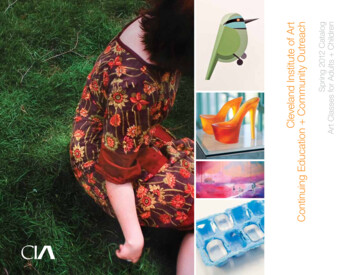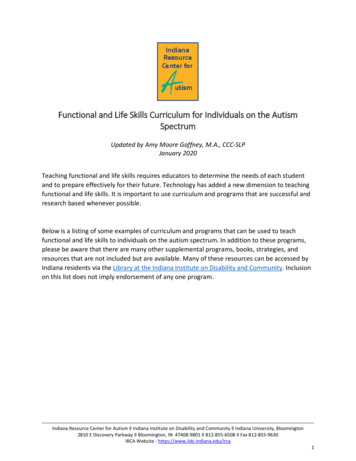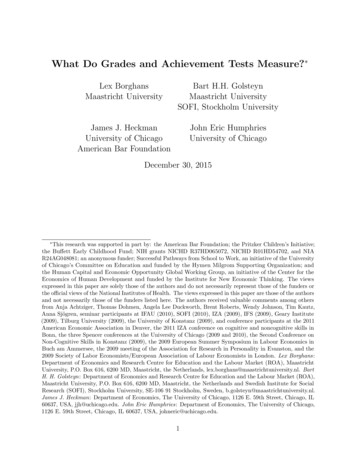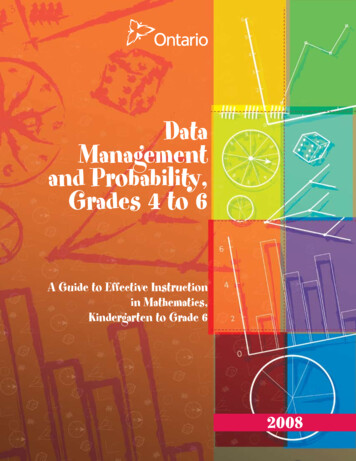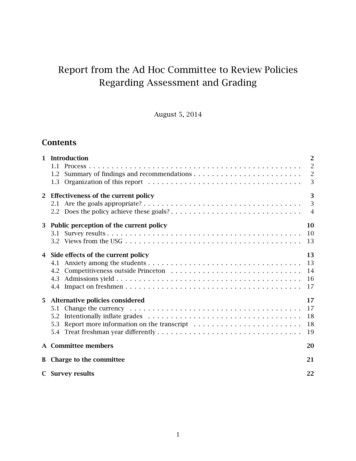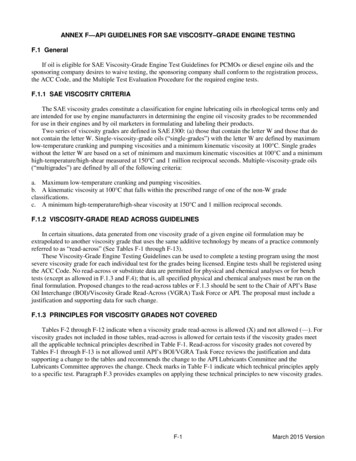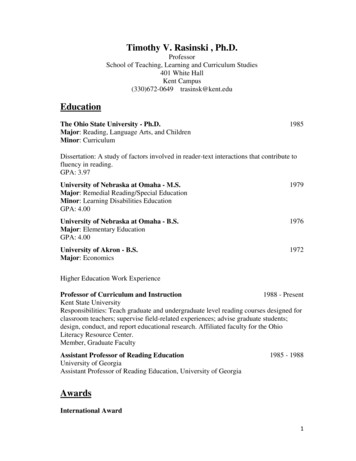
Transcription
Grades 9 to 12 Health Problems SeriesSmokingKidsHealth.org/classroomTeacher’s GuideThis guide includes: Standards Related Links Discussion Questions Activities for StudentsEven though just about everyone knows how dangerous tobacco is, 90% of smokersstart before age 18. Many teens who smoke never expect to become addicted, andpeer pressure can interfere with trying to quit. The following activities will helpyour students better understand the consequences of tobacco use, why teens mightfeel pressured to smoke, and strategies for kicking this deadly habit.Related KidsHealth LinksArticles for Teens: Reproducible MaterialsSmokingTeensHealth.org/teen/cancer center/q g s TobaccoThis guide correlates withthe following National HealthEducation Standards:Students will: Comprehend concepts relatedto health promotion anddisease prevention to enhancehealth. Analyze the influence offamily, peers, culture, media,technology, and other factorson health behaviors. Demonstrate the ability toaccess valid information andproducts and services toenhance health. Demonstrate the ability to useinterpersonal communicationskills to enhance health andavoid or reduce health risks. Demonstrate the ability touse decision-making skills toenhance health. Demonstrate the ability to usegoal-setting skills to enhancehealth. Demonstrate the ability topractice health-enhancingbehaviors and avoid or reducehealth risks. Demonstrate the ability toadvocate for personal, family,and community health.National Health EducationStandards: mTeensHealth.org/teen/drug alcohol/tobacco/smokeless.htmlSmoking and AsthmaTeensHealth.org/teen/drug alcohol/tobacco/smoking asthma.htmlPeer PressureTeensHealth.org/teen/your mind/friends/peer pressure.htmlHow Can I Quit Smoking?TeensHealth.org/teen/cancer center/q a/quit smoking.htmlStop Smoking: Your Personal PlanTeensHealth.org/teen/your body/take care/smoking plan.htmlSecondhand SmokeTeensHealth.org/teen/drug alcohol/tobacco/secondhand smoke.htmlDiscussion QuestionsNote: The following questions are written in language appropriate for sharing withyour students.1.Name some long- and short-term effects of smoking.2.Why does smoking shorten your life? By how much?3.Why do some teens try smoking, and continue smoking, even though they knowthe risks?4.Why is smoking so hard to quit?5.How can you help friends or family members quit smoking?6.Have you been in a situation where someone has pressured you to use tobacco? 2015 The Nemours Foundation/KidsHealth. Reproduction permitted for individual classroom use.
Grades 9 to 12 Health Problems SeriesSmokingActivities for StudentsNote: The following activities are written in language appropriate for sharing with your students.It’s Good To Be a QuitterObjectives:Students will: Investigate the long-term consequences of smoking among former smokers Create public service announcement videos to encourage teens to quit smoking or not start smokingMaterials: Video equipmentActivity:[Note to instructor: This activity can be done individually, in small groups, or as a class. Students can view the“Tips From Former Smokers” videos at /videos to help guidetheir production.] We’re going to take a successful strategy used by health experts at the U.S. Centers for DiseaseControl to create our own public service announcement videos to get people, especially students, to quit, or noteven start, using tobacco. The “Tips From Former Smokers” ad campaign by the CDC has helped many smokers quitpermanently. The anti-tobacco ads were successful, according to CDC Director Dr. Tom Frieden, because “The factthat you may die is not highly motivating to people. The fact that the remainder of your life may be very unpleasantis.” To find subjects for our PSA video, we’ll ask our family members and friends if they know any ex-smokers whosurvived a tobacco-related illness. We can also call the public relations departments of local hospitals and healthagencies. We’ll use the “Tips From Former Smokers” videos as production guides, and share our final videos withother students at a school assembly.Extension:Have your students go online and determine how to get involved as a class in Kick Butts Day (by the Campaign forTobacco-Free Kids) in March, World No Tobacco Day (by the World Health Organization) in May, or the Great AmericanSmokeout (by the American Cancer Society) in November. Your class could also lead a school-wide or communityeffort to participate in one or more of these events. 2015 The Nemours Foundation/KidsHealth. Reproduction permitted for individual classroom use.
Grades 9 to 12 Health Problems SeriesSmokingBurning a Hole in Your WalletObjectives:Students will: Calculate and contextualize the monetary cost of smoking cigarettesMaterials: “Burning a Hole in Your Wallet” handoutClass Time: 15 minutesActivity:Instructions: If each pack of cigarettes costs 5.75, use to “Burning a Hole in Your Wallet” handout to show howmuch a smoker would spend in a year. Then write down what you might do with each amount of money rather thanspending it on tobacco products.Extension:Research and discuss the taxes your state places on tobacco to discourage use. Have your class discuss if similartaxes should be placed on other unhealthy products. What kinds of products should be taxed in this way? Shouldthese kinds of taxes go into general budget funds, or be dedicated for spending in certain ways, such as publichealth initiatives related to the items taxed? 2015 The Nemours Foundation/KidsHealth. Reproduction permitted for individual classroom use.
Grades 9 to 12 Health Problems SeriesSmokingUnder PressureObjectives:Students will: Explore ways to deal with tobacco -related peer pressure Identify strategies to resist negative peer pressureMaterials: “Under Pressure” handoutPens or pencils, paperTeensHealth.org article, “Peer Pressure”Class Time:One hourActivity:Even though we know about the risks and consequences tobacco use, some teens believe smoking is cool and feelpeer pressure to try or continue smoking. You and your friends can influence each other’s choices and behaviors inpositive and negative ways. The pressure to conform is hard to resist, so many teens take the easy way out and makeunhealthy choices. First, read the TeensHealth.org article titled, “Peer Pressure.” Then you and a partner will createa scenario in which a teen is feeling peer pressure to smoke. Think about the characters, setting, and strategies thatteens can use when they’re feeling pressured to make an unhealthy choice.Extensions:1.Talk to an adult you trust about peer pressure he or she faced as a teen, and how he or she dealt with thatpressure.2.Create posters for school hallways listing the Top 10 reasons to stay away from tobacco.3.Talk to adults in their 60s or older about how attitudes toward smoking have changed since they were teenagers.Reproducible MaterialsHandout: Smoking: Burning a Hole in Your s/smoking handout1.pdfHandout: Smoking: Burning a Hole in Your Wallet Answer moking handout2.pdfHandout: Under ugs/smoking handout3.pdfQuiz: gs/smoking quiz.pdfAnswer Key: gs/smoking quiz answers.pdfKidsHealth.org is devoted to providing the latest children’s health information. The site, which is widelyrecommended by educators, libraries, and school associations, has received the “Teachers’ Choice Awardfor the Family” and the prestigious Pirelli Award for “Best Educational Media for Students.” KidsHealth comesfrom the nonprofit Nemours Foundation. Check out www.KidsHealth.org to see the latest additions! 2015 The Nemours Foundation/KidsHealth. Reproduction permitted for individual classroom use.
Health Problem SeriesSmokingName:Date:Burning a Hole in Your WalletInstructions: If each pack of cigarettes costs 5.75, calculate how much a smoker would spend in a year if he or she smoked theamounts listed below. Then write down what you might do with each amount of money.1 Pack Per WeekTotal for year:Half a pack a dayTotal for year:1 pack a dayTotal for year:1.With the amount of money from a pack of cigarettes a week, I could:2.With the amount of money from a half a pack of cigarettes a day, I could:3.With the amount of money from a 1 pack of cigarettes a day, I could:4.With the amount of money from a 1½ packs of cigarettes a day, I could:1½ packs a dayTotal for year: 2015 The Nemours Foundation/KidsHealth. Reproduction permitted for individual classroom use.
Health Problem SeriesSmokingBurning a Hole in Your Wallet Answer KeyInstructions: If each pack of cigarettes costs 5.75, calculate how much a smoker would spend in a year if he or she smoked theamounts listed below. Then write down what you might do with each amount of money.1 Pack Per WeekHalf a pack a day1 pack a day1½ packs a day 5.75 X 52 weeks 5.75 / 2 2.9x 365 days 5.75 X 365 days(or 1,049.38 X 2) 5.75 X 1.5 8.7X 365 days(or 2,098.75 X 1.5)Total for year: 1,049.38Total for year: 2,098.75Total for year: 3,148.13Total for year: 2991.With the amount of money from a pack of cigarettes a week, I could:2.With the amount of money from a half a pack of cigarettes a day, I could:3.With the amount of money from a 1 pack of cigarettes a day, I could:4.With the amount of money from a 1½ packs of cigarettes a day, I could: 2015 The Nemours Foundation/KidsHealth. Reproduction permitted for individual classroom use.
Health Problems SeriesSmokingNames:Date:Under PressureInstructions: With a partner, write a scenario in which a teen is being pressured to smoke. Then act out your scene in frontof your class. Make sure to include at least two strategies teens can use to resist negative peer pressure.Characters:Scenario:Resistance strategies: 2015 The Nemours Foundation/KidsHealth. Reproduction permitted for individual classroom use.
Health Problems SeriesSmokingName: Date:QuizInstructions: Answer each question.1.By how many years can smoking shorten a person’s life?2.What percentage of tobacco users start smoking before age 18?3.Name three health problems caused by smoking:4.True or false: E-cigarettes are not safe; they’re just another way of putting nicotine — a highly addictive drug — into yourbody.5.True or false: Smokeless tobacco is the only safe way to ingest tobacco.6.Breathing in secondhand smoke does not increase a person’s risk for:a) asthmab) bronchitis and pneumoniac) cancerd) dyslexiae) heart disease7.True or false: Secondhand smoke contains thousands of chemicals — from arsenic and ammonia to hydrogen cyanide — manyof which have been proven to be toxic or to cause cancer (called carcinogens).8.List two reasons why teens start smoking:9.Name one strategy you can use to resist any pressure to smoke:10. List three reasons to stay smoke free: 2015 The Nemours Foundation/KidsHealth. Reproduction permitted for individual classroom use.
Health Problems SeriesSmokingQuiz Answer Key1.By how many years can smoking shorten a person’s life?10 years or more2.What percentage of tobacco users start smoking before age 18?90%3.Name three health problems caused by smoking:Any three of the following: cancer, emphysema, heart disease, stroke, pneumonia, bronchitis4.True or false: E-cigarettes are not safe; they’re just another way of putting nicotine — a highly addictive drug — into yourbody.5.True or false: Smokeless tobacco is the only safe way to ingest tobacco.6.Breathing in secondhand smoke does not increase a person’s risk for:a. asthmab. bronchitis and pneumoniac. cancerd. dyslexiae. heart disease7.True or false: Secondhand smoke contains thousands of chemicals — from arsenic and ammonia to hydrogen cyanide — manyof which have been proven to be toxic or to cause cancer (called carcinogens).8.List two reasons why teens start smoking:Any two of the following: to be cool, having family members or friends who smoke, peer pressure9.Name one strategy you can use to resist any pressure to smoke:Any one of the following: listen to your inner voice, plan for possible situation with catch phrases, hang out with friendswhofeel the same as you, blame your parents for not letting you smoke, get comfortable saying no10. List three reasons to stay smoke free:Any three of the following: live a longer life, have more energy, look and feel better, save money, be more active 2015 The Nemours Foundation/KidsHealth. Reproduction permitted for individual classroom use.
3. Why do some teens try smoking, and continue smoking, even though they know the risks? 4. Why is smoking so hard to quit? 5. How can you help friends or family members quit smoking? 6. Have you been in a situation where someone has pressured you to use tobacco? Teacher’s G
